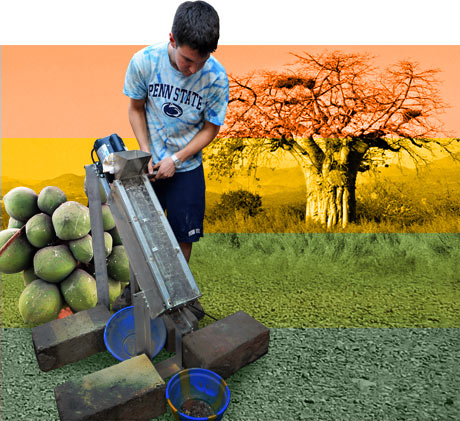Innovation Helps Process the Baobab Fruit
Innovation Helps Process the Baobab Fruit


In Benin and elsewhere in Africa, rural villagers depend on the fruit of the giant baobab tree as a much-needed cash crop. But processing the large fruit, about the size of an American football with a shell as hard as a coconut, is laborious and time consuming, requiring workers to beat the fruit with large mortars and pestles. Now, working with a women's cooperative in Benin, a group of Penn State University engineering students has simplified the task by developing a machine that separates the pulp from the seeds.
Working over the course of the 2010 – 2011 and 2011 – 2012 academic years, the students designed and fabricated three versions of the machine, tested it, and refabricated it in Africa using local tools and materials to ensure it could be repaired or replicated by local villagers. It was an exercise in engineering, manufacturing, and cultural awareness.
"It was a lot of trial and error," says team leader Matt Zellers, a June graduate who earned his bachelor's degree in mechanical engineering. "We were able to create a design that was effective for someone else."
Students Collaborate with Co-Op
As designed, the machine is powered by a 120-V AC motor that rotates a milled grinder against a stationary mesh to grind the fruit pulp into powder and separate it from seeds and fibers. It can process about 100 kg per day of the fruit, which is high in many vitamins and is in demand in Europe as an ingredient in food products, including as a sweetener or a thickener for jams and jellies. It has a tart, tangy taste, and is used in drinks throughout Africa.
PSU students have been investigating solutions to baobab processing since 2008, when engineering Professor Rick Schuhmann became aware of the situation. Schuhmann, director of PSU's Engineering Leadership Development Minor, Leadership Innovation and Global Resource Challenges, says it was an ideal way to engage students in hands-on, problem-based learning.
Students produced a website on the baobab project, and in 2010, a member of a baobab cooperative in the village of Natatingou, Benin, e-mailed Zellers looking for help. "I was kind of blown away by that," says Zellers, who took the request to Schuhmann. He gave the go-ahead, but insisted the students work with the co-op to understand the local operation and how it fit into the community.
"We began by assessing what their needs were," Schuhmann says. "We wanted to be careful. We could design a big machine and destroy the jobs of 30 workers, so we moved slowly through the process."
The team's first design produced a large machine, fabricated on campus at PSU's machine shop, from student-produced CAD images. Zellers says it took the team eight weeks to develop the prototype. After on-campus testing, the students disassembled the machine and shipped it in five boxes to Benin, where they were to reassemble it over winter break in 2010.
Unfortunately, one of the crates containing most of the key assembly parts was lost in transit. Although the students could not test or operate the machine, they used the time to work with the women of the co-op to further determine needs and conditions later used in tweaking the design.
"Seven thousand miles from home and we couldn't do anything," recalls Zellers. "But it was a good lesson."
Improving the Design
The team went back again in December 2011, this time with a smaller machine but troubles came again. "We didn't have the correct motor," says Zellers. The students used a 120-V motor, but "We blew it out after plugging it in," he says.
The team salvaged the 220-V motor from the original machine but still needed to fabricate new parts for those damaged in the mishap. Fortunately, one of the villagers found a machine shop with a lathe, drill press, and welding material. On the last day of their stay, the students finally got the machine operating.
"The goal was to get them finished by December," says Zellers. "The processing season goes from January to April."
By the third iteration, the team had reduced the machine's size by half, says Zellers. This time, however, they took it to Ecole Mohammadia d'Ingenueurs (EMI), a Moroccan university with which PSU's engineering leadership development minor program works to promote cross-cultural collaboration. Prior to the visit over spring break in March, the PSU student design team worked remotely with their Moroccan peers via computer hookup.
At the campus in Rabat, students from both schools replicated the machine in four days using equipment and material available locally. The idea, says Zellers, was "to build the machine with African parts on the African continent" to confirm that it could be repaired and maintained by the co-op.
It wasn't easy. The Moroccan equipment was not as advanced as PSU's computerized water jet and other tools. "We had to do things by hand, and that obviously is not as accurate," says Zellers.
In the end, the students produced two machines; a processing operation in Togo bought one, and the Benin co-op the other. Although Zellers has graduated, another group of engineering students will pick up the project again when school begins in September.
We began by assessing what their needs were. We wanted to be careful. We could design a big machine and destroy the jobs of 30 workers, so we moved slowly through the process.Prof. Rick Schuhmann, Penn State University


.png?width=854&height=480&ext=.png)


